
“My one regret is that I didn’t stay at RMC longer. I suspect that if I had, several of the cadets would have competed as members of the Canadian team in the Montreal Olympics.”
Les “Babe” Mason
e-veritas: At which Military College did you serve?
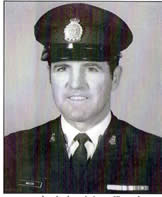 Les (Babe) Mason: I served at the Royal Military College in Kingston from 1969-71 as the senior physical education and recreation instructor. When I was stationed at Camp Borden from 1957-8, and 63-5, I would see the RMC cadets during their summer training, but I didn’t have the chance to work with them directly. The Cadets called me Mr. Mason, or coach. My older brother nicknamed me Babe when I was born, and I have remained Babe to friends and family ever since.
Les (Babe) Mason: I served at the Royal Military College in Kingston from 1969-71 as the senior physical education and recreation instructor. When I was stationed at Camp Borden from 1957-8, and 63-5, I would see the RMC cadets during their summer training, but I didn’t have the chance to work with them directly. The Cadets called me Mr. Mason, or coach. My older brother nicknamed me Babe when I was born, and I have remained Babe to friends and family ever since.
e-veritas: How did you come to be a PERI?
Les (Babe) Mason: I was born 18 Aug1934 and raised in Stellerton NS, I served with the North Nova Scotia Highlanders, initially with the 1st Highland battalion then with the 2nd Highland. In 1951, I transferred to the Black Watch. I served in Korea in 1954, when the army announced the establishment of the army physical training branch. At the time, I was a sergeant who was interested in sports and athletics. I took my first physical training course in 1 course in Japan with the British. I then completed my physical training in Borden from 1957-8.
At Borden, I was exposed to gymnastics later competed as part of the Display Team. My wife Shirley (MacDonald) and I were married 23 Oct 1957 and raised three children, Wayne, Glen and Cathy. I re-mustered to the Army PTS in 1958. I served in Aldershot NS (3), Valcartier, Halifax, Wainwright, Korea, Gagetown, Borden, Edmonton, RMC, Cornwallis, Halifax and retired from Cornwallis as a CWO in 1981. I also completed a three year Recreation Director’s Course in Alberta.
e-veritas: I understand that your primary sport was boxing.
Les (Babe) Mason: Yes. In 1953, I was the Wainwright welterweight champ; 1954-Commonwealth Forces welterweight champ Korea. In 1956, I won the East Comd Army welterweight title, plus named the best boxer. I won the Army championship in 1956 and earned a place on Canada’s Olympic Team, giving up a close decision for a medal in Melbourne Australia. In 1957, I won the Army welterweight and the Canadian title. In 1958, I won his 3rd Army title. I was the Referee-in-chief for the NS Boxing Association during the 1970s. In 1976, I managed the boxing training facilities at the Montreal Olympics.
e-veritas: Did you also coach or be involved with a varsity team? Explain.
Les (Babe) Mason: I coached the RMC boxing team, which beat the University of Toronto in 1970. I coached minor hockey. I was a playing coach of the RMC staff volleyball, hockey and softball teams. I also played on the base badminton team. In the fall of 1970, I was the physical trainer for the newly formed Buffalo Sabres under Punch Imlach in 1970 (while on leave).
e-veritas: Please describe badminton? Do you have any tips?
Les (Babe) Mason: Badminton is a racquet sport in which singles or doubles, score points by striking a shuttlecock once with their racquet over the net and lands on the ground in their opponents’ half of the court. When you are in front of the net, be sure to cover your face with the racket. The first time I played, I got a bird in my eye and didn’t play badminton again for 10 years. In the end, I won five national Badminton Championships. In 1968 I won the Edmonton District Badminton Doubles in the Senior B Category.
e-veritas: What was your primary duty?
Les (Babe) Mason: I was in charge of the physical training and recreation instructor staff. At the time, boxing was mandatory for all 1st year cadets. After the cadets boxed off by Squadron, the winners boxed against each other for the Cadet championship. I instructed the 1st & 2nd year cadets in boxing and physical fitness. I also ran the dependents swimming program at RMC.
e-veritas: What do you consider the high-light of serving at the Military College?
Les (Babe) Mason: Serving at the Military College was the high-light of my career as a PERI. It was the ideal place to serve as a PERI. I enjoyed working with the cadets.
In 1971, two of the second year cadets I coached were members of the Ontario boxing team and competed in the Canada Games in Saskatoon: 9290 Major (Ret`d) Arthur Rent (RMC 1972) and 9001 Captain (Ret`d) Warren L Wasylik (RRMC RMC 1971). Another cadet, 8588 LCol (Ret’d) William S Tait (RRMC RMC 1970) continued to box after he left the college. My one regret is that I didn’t stay at RMC longer. I suspect that if I had, several of the cadets would have competed as members of the Canadian team in the Montreal Olympics.
e-veritas: What were the challenges of serving as a PERI?
Les (Babe) Mason: In the military, during the late 60s early 70s it was unclear whether the emphasis should be on recreation or physical training. The emphasis seemed to vary, based on the head of the department. The Army and Navy emphasised physical training and sports, while the Air Force emphasized recreation. The Army and Navy physical training was based on British programs, which were outlined in various pamphlets and tables. In contrast, the Air Force books were written in Canada. In the early days, the facilities were modest and there was limited access to coaching or equipment. I was very fortunate to have been coached by some terrific coaches in the Army.
The system was very regimented and more than a little dull for cadets who already knew the fundamentals of the sport. The expectation was that the PERI would expose a cadet to the fundamentals of a sport: for example, box horses for gymnastics, or the breast stroke for swimming and the cadet would master it within a short period of time. Earning a bronze medallion in swimming, for example, was relatively easy for a guy who swam every summer and very hard for a guy who had never been in the open water. (He won the tri-service East Comd 200m breast stroke. He was a Red Cross and RLSS instructor and examiner in NB.)
When I trained members of the Airborne Regiment in Edmonton, I had the opportunity to mix up the program adding elements of cardio, weight training and adventure sports. Personnel from 20 to 52 years of age were to run as they went from place to place between 8-4:30 pm. In addition to climbing in the gym, we went mountain climbing to practice our rope skills. In addition to swimming in a pool, we swam outdoors for 8 hours.
e-veritas: What are you doing these days?
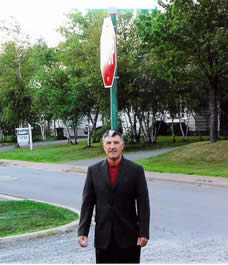 Les (Babe) Mason: I was a track and Field Official at the 1976 Pan-Am Games in Winnipeg. I was awarded the Queen’s Jubilee Medal in 1978. I was inducted into the CF Sports Hall Of Fame in 1980. I retired from the Army as a CWO in 1981. I moved back to Stellerton NS. In 1982, my ball team, the Bullpen Oldtimers won the NS Softball Provincial Championship. My Legion Hockey team won another provincial title. In 1984, I became the owner of Olympic Auto Sales in Stellarton NS. Although I sold Olympic Auto Sales in 2007, I am still involved in the business. The Town Council named a street in Stellerton, Babe Mason Way.
Les (Babe) Mason: I was a track and Field Official at the 1976 Pan-Am Games in Winnipeg. I was awarded the Queen’s Jubilee Medal in 1978. I was inducted into the CF Sports Hall Of Fame in 1980. I retired from the Army as a CWO in 1981. I moved back to Stellerton NS. In 1982, my ball team, the Bullpen Oldtimers won the NS Softball Provincial Championship. My Legion Hockey team won another provincial title. In 1984, I became the owner of Olympic Auto Sales in Stellarton NS. Although I sold Olympic Auto Sales in 2007, I am still involved in the business. The Town Council named a street in Stellerton, Babe Mason Way.
http://www.theperiscope.ca/Babe.htm
___________________________________________________________________________________
“I frequently used circuit training since the gym facilities at RMC were basic and the classes consisted of 20-30 cadets.”
Art Vondette
e-veritas: At which Military College did you serve?
Art Vondette: I served as part of the athletic staff at the Royal Military College of Canada for 8 years from 1961-69.
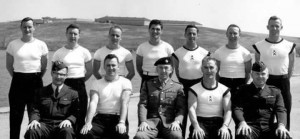
In 1966-7, the athletic staff at RMC included: Back L-R: Bob Murray, Bruce Porter, Art Vondette, Wally Travis, Tom Walton, Jim Gebhart, Max McClelland and Front L-R: Hank Tatarchuk, Rick Bourgon, Danny McLeod, Reg Pitt, Doug Hargraves
e-veritas: What was your primary duty?
Art Vondette: I was a physical education and recreation instructor. I instructed a wide variety of Physical Education and Recreation activity classes.
e-veritas: How did you come to be a Physical Education and Training Instructor (PERI) at RMC?
Art Vondette: I served initially the infantry in the Black Watch although I had transferred to the Signals and was serving in Kingston, Ontario. I was an athlete who competed in marathons and in the modern pentathlon. Another PERI recommended me for a posting at RMC. Since I was already serving in Kingston in the Signals, and I had recently completed the Physical Education and Training Instructor training at Borden, it was relatively easy to move over to RMC.
e-veritas: I understand that you competed in the Modern Pentathlon at the World Championships. Describe the events.
Art Vondette: The pentathlon consists of five sporting events:
1 mile, 200 yards, the high jump, Discus throw, and javelin. In non-Olympic years, a World Championship is held. I had the opportunity to compete in the Masters Class at two World Championships in the modern pentathlon. Points for each event are combined to give the overall total scores.
e-veritas: Describe circuit training at RMC in the late 60s-early 70s.
Art Vondette: In the late 60s-early 70s, I frequently used circuit training since the gym facilities at RMC were basic and the classes consisted of 20-30 cadets. Circuit training is an interval training combining endurance, aerobic and strength for a cardiovascular and strength training workout. Three or four cadets would work out at ‘stations’ positioned around the facility that were to be visited in rapid succession. The stations includes those comprising resistance equipment (e.g. medicine balls, Indian clubs or free weights), and spaces to do squat thrusts, push ups, jumping jacks, sit-ups, and other exercises. Each person completed the activity in one station before they proceed to the next station until they passed through all stations once or twice or until a certain time requirement has been met.
e-veritas: Did you also coach or be involved with a varsity team? Explain.
Art Vondette: Yes. I coached the RMC track and field team and the X-Country running team. Most weekends, I borrowed one of the military vehicles and drove the teams to out of town events.
e-veritas: What do you consider the high-light of serving at the Military College?
Art Vondette: I enjoyed my time serving at the Military College, which was the highlight of my military career. One highlight was when I helped organize the annual athletic awards event at RMC. One year, we invited three Canadian Olympic athletes to give motivational speeches at the awards event. The 3 athletes that I drove from Toronto for the Awards Diner were–Nancy Green, Elaine Tanner, Teresa MacDonnell. Olympian Nancy Green, for example told her Olympic story and shared her insights, perspectives, tools and tactics, and lessons learned along the way.
e-veritas: What are you doing these days?
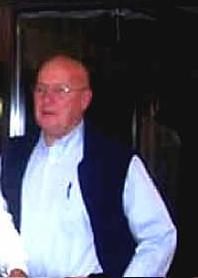 Art Vondette: I work as a commissionaire at the Olds Agricultural College. My wife Marg & I live in Olds, Alberta. I am serving as 1st Vice President of the Royal Canadian Legion 105 in Olds, Alberta. At the Legion, the winter sports include darts, shuffleboard, crib, and bridge. I am a Faithful Navigator with the Knights of Columbus, Mother Teresa of Calcutta Assembly No. 2853. In 2004-5, Assembly No. 2853 was a winner of the “The Patriot’s Challenge.” I do a lot of fundraising, recently for a local skate park and the purchase of a handicapped accessible vehicle. If you are in Olds, Alberta be sure to look us up! To stay active, I enjoy walking, jogging and playing bridge. margart@telus.net
Art Vondette: I work as a commissionaire at the Olds Agricultural College. My wife Marg & I live in Olds, Alberta. I am serving as 1st Vice President of the Royal Canadian Legion 105 in Olds, Alberta. At the Legion, the winter sports include darts, shuffleboard, crib, and bridge. I am a Faithful Navigator with the Knights of Columbus, Mother Teresa of Calcutta Assembly No. 2853. In 2004-5, Assembly No. 2853 was a winner of the “The Patriot’s Challenge.” I do a lot of fundraising, recently for a local skate park and the purchase of a handicapped accessible vehicle. If you are in Olds, Alberta be sure to look us up! To stay active, I enjoy walking, jogging and playing bridge. margart@telus.net
e-veritas: Do you have any particular memory or short story you would like to share with our readers?
Art Vondette: I had the opportunity to carry the Olympic torch about 400 metres in Rockland Ontario during its trek across Canada for the 1976 Summer Olympics in Montreal. I was permitted to keep my torch, which Marg and I display in our home in Olds, Alberta. Rather than running alone, I ran with a dozen serving members of the forces. I have also applied to get a shot at one of the 12,000-plus torchbearer slots in 2010 for the Vancouver Olympics.
___________________________________________________________________________________
“Although the cadets were very strong academically, most were average in fitness programs. The athletic program involved teaching the basics of introduction to various sports and fitness.”
John Smith
e-veritas: At which Military College did you serve?
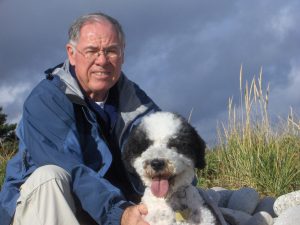 John Smith: I served in the athletic staff at the Royal Military College in Kingston from 1980-4. One of my memories of the college is admiring the crossed lances mounted on the wall in the Senior Non Commissioned Officer mess, at the Sir Archibald Macdonnel (SAM) Athletic Centre. Lances had been used in jousting, a sport played by two armored combatants mounted on horses.
John Smith: I served in the athletic staff at the Royal Military College in Kingston from 1980-4. One of my memories of the college is admiring the crossed lances mounted on the wall in the Senior Non Commissioned Officer mess, at the Sir Archibald Macdonnel (SAM) Athletic Centre. Lances had been used in jousting, a sport played by two armored combatants mounted on horses.
e-veritas: Do you recall any Skylarks at the College?
John Smith: I recall several skylarks. At that time, the cadets were expected to know how many pickets were on the fence around the Commandant’s house. Some cadets decided the paint the pickets in Squadron colours. Another time, cadets took a 420 sail boat from the RMC boat house and assembled it with sails in the lobby of the mess hall.
e-veritas: What was your primary duty?
John Smith: I was a physical education recreation instructor at RMC from 1980-4. Although the cadets were very strong academically, most were average in fitness programs. The athletic program involved teaching the basics of introduction to various sports and fitness.
e-veritas: I understand you were at RMC when the first 32 Lady Cadets arrived.
John Smith: Yes. RMC became co-educational in 1980. Once the first 32 Lady Cadets stated at the College, the physical education classes were co-ed. I recall the novelty of each squadron having 4 lady cadets. We didn’t modify the classes or fitness test to accommodate the lady cadets. Novice boxing was dropped in 1980. Several of the Lady Cadets were very athletic, one in particular fenced at the varsity level. I recall that fraternization between the male cadets and lady cadets was not permitted but certainly went on. A few Cadets dated and a few got married.
I was also the Constantine Hockey Arena manager from 1983-4.
e-veritas: How did you come to be a PERI?
John Smith: I joined the Air Force in 1963 and served until 1971 as a military policeman. I remustered as a PERI in 1971. I was interested in sports and played fastball, golf, soccer, hockey, broomball, tennis, squash and racquetball. The only sports I didn’t pay were lacrosse, field hockey and rugby. Although our facilities were nice in the early 80s, I was very impressed the last time I toured RMC’s facilities. I also tip my hat to the athletic staff in the 50s who instructed in the Old gym with little more than ropes and Indian clubs.
e-veritas: What are your memories of 3173 MGen (Ret) John A. Stewart CD, ADC (RMC 1953), the Commandant of RMC 80-2.
John Smith: Normally, a sergeant and a General don’t have a lot of interaction. Following our time at RMC we were both posted to NDHQ. While at Ottawa, I jogged during the noon hour with General Stewart regularly. We chatted about the weather and family issues. One day, for example, we discussed the septic tank problems he was having at his summer cottage. I provided some advice since I had had similar problems in my trailer.
e-veritas: Did you also coach or be involved with a varsity team? Explain.
John Smith: I was the assistant coach of the RMC football team from 1980-1. I was responsible for the halfback, quarterback and flankers. At the time, RMC competed with other Ontario Community Colleges. We frequently travelled to Toronto to compete. Football was dropped in 1981. During the athletic awards banquet, I presented the last football to the Commandant, BGen John Stewart.
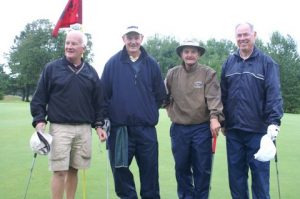 Most of the athletic staff coached at the Varsity level. Some coached teams in the summer and winter. We appreciated the extra recognition and opportunities to develop our coaching skills. The cadets called me Sergeant or Coach. (CISM commemorated the 61st anniversary in 2009). In the early 80s, the International Military Sports Council – Conseil International du Sport Militaire (CISM) first came into prominence at the College The first years of CISM were hit and miss; it took years for cadets to be competitive at the international competition level. (Picture just above – four former PERIs who previously served at RMC – Greg Peet; Tom MacKay; George Springer; and John Smith. Photo was taken on a golf course in Summerside, PEI as part of a 2007 PERI reunion. A similar reunion is scheduled for late August this year.
Most of the athletic staff coached at the Varsity level. Some coached teams in the summer and winter. We appreciated the extra recognition and opportunities to develop our coaching skills. The cadets called me Sergeant or Coach. (CISM commemorated the 61st anniversary in 2009). In the early 80s, the International Military Sports Council – Conseil International du Sport Militaire (CISM) first came into prominence at the College The first years of CISM were hit and miss; it took years for cadets to be competitive at the international competition level. (Picture just above – four former PERIs who previously served at RMC – Greg Peet; Tom MacKay; George Springer; and John Smith. Photo was taken on a golf course in Summerside, PEI as part of a 2007 PERI reunion. A similar reunion is scheduled for late August this year.
e-veritas: What do you consider the high-light of serving at the Military College?
John Smith: The four years at RMC, were the best in my career. I was quite proud of the young men and women, who entered the College from high school. In a few years, they marched off as officers in the Canadian Forces. I felt that I was an integral part of that experience. Over the years, I ran into young officers who I had coached or known from the College. In 1995, for example, I met four young captains in 3rd RCA in Shilo who were undergoing Artillery training.
e-veritas: What are you doing these days?
John Smith: At 66 years of age, I am semi retired. Since retiring from the Canadian Forces in 1997, I worked for the Canadian Corps of Commissionaires for 9 years in Toronto and 3 in Halifax. Although I have no aches and pains, I am getting older. Phyllis (Smart) and I live in Dartmouth Nova Scotia. To stay fit, we take long walks with our dog. smartsmith@ns.sympatico.ca
e-veritas: Describe teaching the cadets to skate?
John Smith: Since some of the cadets didn’t know how to skate, and didn’t have anywhere to go on Friday night, I taught a coed beginners skating class in the hockey arena. LCdr John Russell, the athletic director ordered skates. The cadets enjoyed the opportunity to ice skate and to fraternize during this unmonitored period. I took the Canadian figure skating course and adapted it to adults of 18-19 years of age. Rather than apply drills, I used skating games to have the cadets practice their skating skills. When the cadets played tag on the ice, the cadets who was `it` wore Sock’em Boppers, oversize air-inflated boxing gloves. The cadets enjoyed the unique skating drills in which they practiced their stops, starts, outside edges, inside edges, forwards and backwards to dodge and avoid each other.

